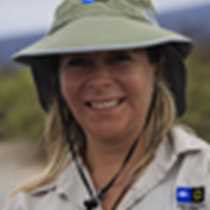Española Island
Espanola and Punta Suarez are the biggest of the jewels of the crown of the Galápagos archipelago. We dry landed at a jetty that was full of animals such as the endemic red marine iguanas from Española, the Española mockingbird, the endemic lava lizards, sea lions and more.
Following a steady pace, the trail took us through nesting colonies of marine birds and marine iguanas to the Española blow hole. This well-known site is a spectacular spring of sea water that sprays up into the air as the waves hit the rugged rocky shores of Punta Suarez.
The bouldery rocky trail took us on a loop to see nesting waved albatrosses, blue footed boobies and the endemic Nazca boobies and we even had three or four sightings of the endemic Galápagos hawk.
We stayed in ecstasy watching the cliffs from where the albatrosses jump off into the air. They are big birds with a wing span of about seven feet and eleven inches and their short legs do not allow them to take off from land so they have to walk out into the cliffs to be able to take off. As they land, though, they could have a little difficulty and most of the times they do what we call the five point landing: feet, wings and beak…bum! As a matter of fact, almost five percent of the mortality of deaths in this species is due to faulty landings.
The adults albatrosses are nesting now. A lot of the nineteen thousand couples that nest on Española Island are incubating their eggs now. By the end of June, the chicks will hatch to be fed by their hard-working parents until January when they will be ready to jump off the cliff and fly off shore towards the far away oceans and wait until next April to come back to Española to nest.
So long beautiful albatrosses!
Don’t forget to keep in touch so we can keep you posted with the news of all the wonderful wilderness you met in the islands.




